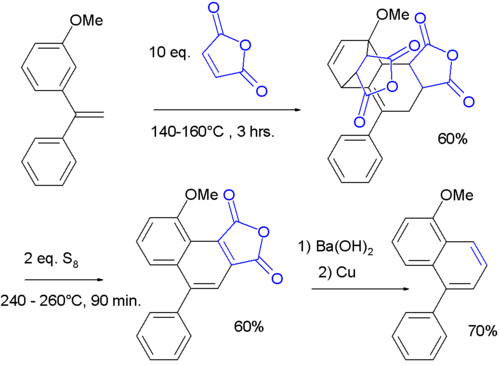Chemistry:Wagner-Jauregg reaction
The Wagner-Jauregg reaction is a classic organic reaction in organic chemistry, named after Theodor Wagner-Jauregg (de) (son of Julius Wagner-Jauregg), describing the double Diels–Alder reaction of 2 equivalents of maleic anhydride with a 1,1-diarylethylene. After aromatization of the bis-adduct, the ultimate reaction product is a naphthalene compound with one phenyl substituent.[1][2] The reaction is unusual in that the anhydride reacts with the aromatic ring. The presence of the additional alpha-phenyl group on the phenylethene (the styryl group) activates the styryl for a Diels–Alder reaction even at the expense of its aromaticity. In contrast, unactivated styrene reacts instead at the alkene alone via a linear polymerization reaction. Styrene maleic anhydride copolymer is formed, retaining the aromaticity of the styrene.
The Diels–Alder product can be re-aromatized using elemental sulfur at high temperature, followed by a second rearomatization by decarboxylation with barium hydroxide and copper:[3]
References
- ↑ Theodor Wagner-Jauregg (1930). "Über addierende Hetero-polymerisation". Berichte der Deutschen Chemischen Gesellschaft (A and B Series) 68 (11): 3218. doi:10.1002/cber.19300631140.
- ↑ Theodor Wagner-Jauregg (1931). "Die Addition von Maleinsäureanhydrid an asymm. Diphenyl-äthylen". Justus Liebig's Annalen der Chemie 491: 1–13. doi:10.1002/jlac.19314910102.
- ↑ Felix Bergmann; Jacob Szmuszkowicz; George Fawaz (1947). "The Condensation of 1,1-Diarylethylenes with Maleic Anhydride". Journal of the American Chemical Society 69 (7): 1773–1777. doi:10.1021/ja01199a055. PMID 20251415.
 |


